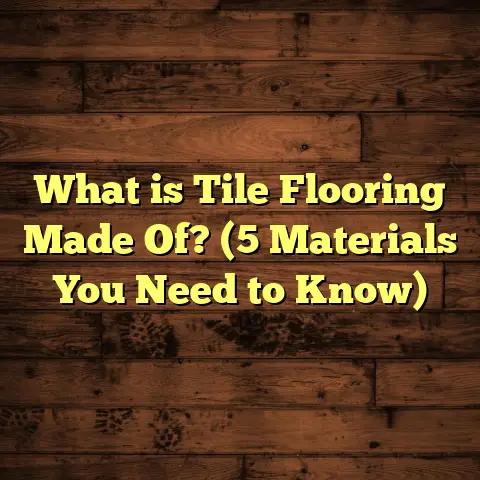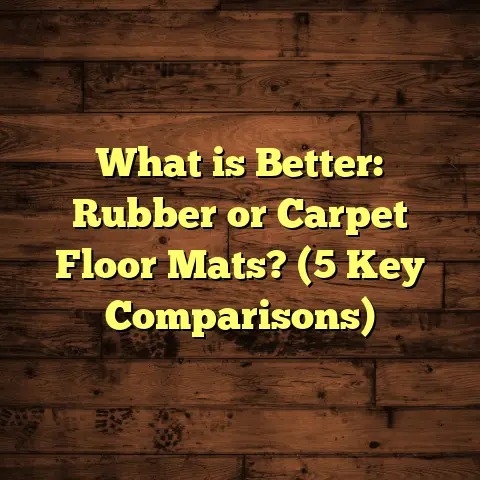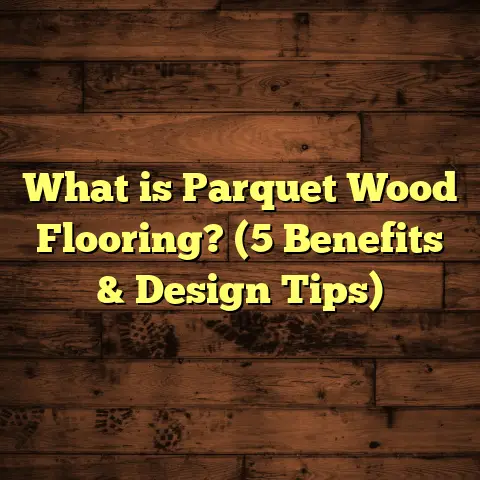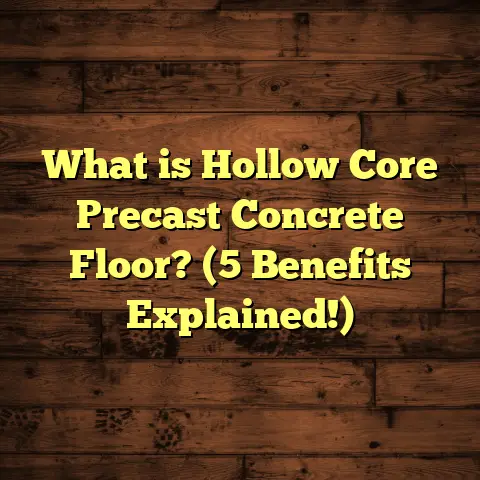What Is Cheaper: Porcelain Wood Look Tile or Wood Flooring? (5 Key Cost Factors Explained)
I’ve always found the way weather shapes our homes fascinating, especially when it comes to flooring. Growing up in a region where summers were scorchingly hot and winters could freeze the ground solid, I quickly learned that not all floors are built to handle every season the same way. Floors take a beating—from humidity, temperature swings, moisture, and heavy foot traffic. So when I started working with different flooring materials professionally and personally, I began paying close attention to which options hold up better and cost less over time. Porcelain wood look tile and wood flooring are two popular choices that often get compared. Both bring that warm wood vibe but differ drastically in price, maintenance, durability, and installation.
Over the years, I’ve gathered a lot of knowledge and real-world data from my projects, suppliers, and homeowners. This article breaks down the five biggest cost factors between porcelain wood look tile and wood flooring. Whether you’re remodeling or building new, these insights will help you figure out what really costs less—and more importantly, what gives you the best value for your money.
What Is Porcelain Wood Look Tile? And What Is Wood Flooring?
Let’s start simple. What exactly are these flooring types?
Porcelain Wood Look Tile Explained
Porcelain wood look tile is porcelain tile crafted to replicate the appearance of natural wood planks. It’s made by firing porcelain clay at extremely high temperatures (about 2,200°F), resulting in a very dense, hard surface. The wood grain patterns are printed or embossed on the surface of the tile using advanced technology so that it looks very close to real hardwood.
This tile comes in planks or squares designed to mimic traditional wood flooring layouts like straight planks, herringbone, or chevron. Because it’s porcelain—the most durable type of ceramic tile—it resists water, stains, scratches, and UV fading better than any other tile option.
I remember working on a kitchen remodel where the homeowner wanted a hardwood look but needed something that could handle spills and humidity without warping. Porcelain wood look tile was perfect—it gave them the cozy wood feel but stood up to the moisture and heavy traffic without any issues.
Wood Flooring: Solid vs Engineered
Wood flooring comes from natural timber and falls primarily into two categories:
- Solid hardwood: These are planks made from a single piece of timber, usually ¾” thick. They can be sanded and refinished multiple times over their lifespan.
- Engineered hardwood: Made from a core of plywood or high-density fiberboard topped with a thin veneer of real wood. It is more dimensionally stable than solid wood across humidity changes but has a limited number of refinishes.
Wood flooring offers unmatched warmth and natural beauty with unique grain patterns and textures. When I installed a solid oak floor in my own home, I appreciated how the floor aged with character over time—something porcelain can’t replicate exactly.
1. Material Costs: Getting Your Hands on the Floors
Material expenses are often where people start budgeting. But prices vary widely depending on quality, brand, and style.
Porcelain Wood Look Tile Material Cost
On average:
- Basic porcelain wood look tiles cost around $3 to $7 per square foot.
- Premium or hand-crafted tiles with extra details can go up to $10 or more per square foot.
- Some luxury brands charge upwards of $15 per square foot for unique finishes or very large plank sizes.
When I sourced tile for a client’s living room recently (900 sq ft), mid-range porcelain wood look tile priced at about $5 per sq ft was recommended. The total material cost came out to approximately $4,500. It was an affordable option compared to other high-end tiles like marble or natural stone.
Wood Flooring Material Cost
Wood flooring prices fluctuate greatly based on species and type:
- Common hardwoods (oak, maple, hickory): $5 to $10 per sq ft
- Exotic woods (mahogany, Brazilian cherry): $12 to $20+ per sq ft
- Engineered hardwood: $4 to $9 per sq ft depending on veneer thickness and quality
For example, red oak—a popular choice for durability and color—averages about $7 per sq ft. That same 900 sq ft space would need roughly $6,300 in materials just for the flooring.
In one project I managed for a client who wanted exotic Brazilian cherry hardwood floors in their dining room (400 sq ft), the material cost alone was around $7,200.
Comparing Material Costs
Material-wise, porcelain wood look tile generally comes out cheaper than hardwood flooring—sometimes significantly so if you’re comparing against premium hardwoods. But don’t let just material price fool you; installation and maintenance add big costs too.
2. Installation Costs: Labor Makes a Difference
Installing floors isn’t just about laying materials down; it’s skilled work that can vary by complexity and local labor rates.
How Porcelain Tile Installation Works
Porcelain tile installation is labor-intensive. It involves preparing a flat substrate (concrete or plywood), applying mortar thinset evenly, laying each tile precisely with spacers, cutting tiles to fit edges or around obstacles, grouting joints once set, sealing grout lines for protection, and allowing drying time between steps.
Because porcelain tiles are heavier and more rigid than wood planks, installation requires specialized tools and experience to avoid damage or uneven surfaces.
Typical labor costs for porcelain tile range from $5 to $10 per square foot, depending on where you live and project complexity.
In one bathroom renovation I oversaw with about 200 sq ft of porcelain wood look tile on the floor and walls, labor costs were around $8 per sq ft—totaling $1,600 just for installation.
Wood Flooring Installation Details
Installing solid hardwood involves acclimating the wood planks to the room’s humidity first—often for several days—then nailing or gluing them down securely. Engineered wood can sometimes be floated over underlayment without nails or glue.
Sanding and finishing solid hardwood floors after installation add extra labor hours depending on your finish choice.
Wood flooring installation usually costs $3 to $8 per square foot, lower than tile in many cases due to simpler prep work and faster laying process.
On a recent project where I installed red oak floors in a family room (800 sq ft), installation labor was about $5 per sq ft or $4,000 total. No grout or mortar meant less mess and shorter project time.
Installation Cost Summary
| Flooring Type | Typical Labor Cost / Sq Ft | Notes |
|---|---|---|
| Porcelain Wood Look Tile | $5 – $10 | More prep & precision required |
| Solid Hardwood | $4 – $8 | Includes sanding & finishing |
| Engineered Hardwood | $3 – $6 | Sometimes floating installation |
Labor can push porcelain tile total project cost up quite a bit even if materials are cheaper. But remember that skilled installation ensures longevity!
3. Maintenance Costs: What Happens After Installation?
Once your floors are down, maintenance affects your wallet over years.
Porcelain Tile Maintenance
Porcelain wood look tile is one of the easiest floors to maintain:
- Regular sweeping or vacuuming removes dirt.
- Mopping with mild cleaners keeps it bright.
- Grout lines need resealing every 3-5 years to prevent staining.
- No refinishing needed; tiles resist scratching and water damage.
I had a client in Florida whose kitchen floor is porcelain tile. Despite spills and heavy cooking use daily for over seven years, their floor looks as good as new without any costly repairs.
Wood Floor Upkeep
Wood floors require more care:
- They must be swept often to prevent grit rubbing that causes scratches.
- Spills should be wiped immediately to avoid water damage.
- Solid hardwood floors typically need refinishing every 7-10 years ($3-$5 per sq ft).
- Engineered wood may have a thinner veneer limiting refinishing frequency.
- Maintaining indoor humidity levels (30-50%) is key to prevent warping or cracking.
In my own house with oak floors, I’ve refinished the floors twice over 15 years at about $4 per sq ft each time—a considerable maintenance expense compared to tile upkeep.
4. Durability and Lifespan: How Long Will It Last?
How long your floors last relates directly to how much you’ll spend over time replacing or repairing them.
Porcelain Tile Durability
Porcelain tiles are incredibly durable:
- Highly resistant to scratches, dents, stains.
- Impervious to water and humidity.
- Can tolerate heavy furniture without damage.
- Resistant to fading from sunlight exposure.
- Usually lasts 50+ years if installed properly.
One commercial project I worked on involved porcelain wood look tile in a busy restaurant kitchen—after 10 years of daily use by staff and customers alike, the floor had no visible wear beyond minor grout discoloration.
Wood Flooring Longevity
Wood flooring lifespan varies by type:
- Solid hardwood can last 30-50 years or more with proper care.
- Engineered hardwood’s lifespan depends on veneer thickness; typically 20-30 years.
- Susceptible to scratches, dents from pets or furniture.
- Vulnerable to water damage if exposed frequently.
In my experience managing homes with hardwood floors across different climates, humidity fluctuations caused some cupping or gaps in poorly maintained installations. Repairs were needed sooner than anticipated in those cases.
5. Aesthetic Value & Resale Impact: What Buyers Want
Some buyers prefer the authentic warmth of wood floors while others appreciate the practicality of durable tiles that mimic wood.
Resale Value of Wood Flooring
According to remodeling impact reports:
- Homes with hardwood floors often sell faster.
- Hardwood flooring can increase home resale value by about 2-3%.
- Buyers perceive wood floors as premium upgrades linked to home quality.
I’ve seen listings where sellers invested in hardwood flooring before putting their homes on market and received offers thousands above comparable properties without wood floors.
Porcelain Tile’s Market Perception
Porcelain wood look tiles have grown popular but still rank slightly below real hardwood in traditional markets:
- Seen as practical and stylish but somewhat less “luxurious.”
- Excellent choice in wet areas like bathrooms or basements where wood isn’t ideal.
Though modern designs have improved buyer acceptance dramatically—especially among younger buyers who value easy maintenance.
Personal Stories & Case Studies From My Projects
I’ve worked with dozens of homeowners weighing these two options. Here are some real examples:
Case Study 1: Family Kitchen Remodel in Humid Climate
A family wanted wood aesthetics but lived in a coastal city with high humidity year-round. We compared red oak hardwood vs porcelain wood look tile:
- Material & installation cost for tile was about 30% less overall.
- Tile handled spills, sand tracked in from outdoors better.
- After 5 years no repairs needed; hardwood neighbors required refinishing twice.
They were thrilled with tile’s durability and ease of cleaning despite initial hesitation about synthetic material feel.
Case Study 2: Retro Living Room Refinish Project
An older couple insisted on authentic hardwood for their historic home:
- They paid premium prices for custom oak planks.
- Installation took longer due to subfloor prep.
- They refinished every decade but enjoyed rich patina development.
Though costlier upfront & ongoing maintenance was needed—they valued traditional beauty above all else.
Final Thoughts: Which Flooring Is Cheaper?
If you want numbers condensed:
| Expense Category | Porcelain Wood Look Tile | Wood Flooring |
|---|---|---|
| Materials | $3-$7/sq ft | $5-$15/sq ft |
| Labor Installation | $5-$10/sq ft | $3-$8/sq ft |
| Maintenance (10 yrs) | Low – just cleaning & grout seal | Moderate-high – refinishing + humidity control |
| Lifespan | 50+ years | 30-50 years |
| Resale Value Impact | Moderate | High |
The cheaper option upfront is often porcelain wood look tile due to lower material cost and durable maintenance profile. Over decades, it remains cost-effective with minimal upkeep required.
Wood flooring costs more initially and demands ongoing care but offers unmatched warmth and resale value for those who prioritize authentic natural materials.
Need Help Budgeting?
Using tools like FloorTally can give you detailed local cost estimates including waste factors so you don’t overspend or run short on materials.
Want advice tailored to your climate or lifestyle? Feel free to reach out—I’m happy to share what I’ve learned from hundreds of floors installed across diverse environments.
Choosing between porcelain wood look tile and real wood flooring isn’t just about price—it’s about what fits your life best. So what feels right for you?





